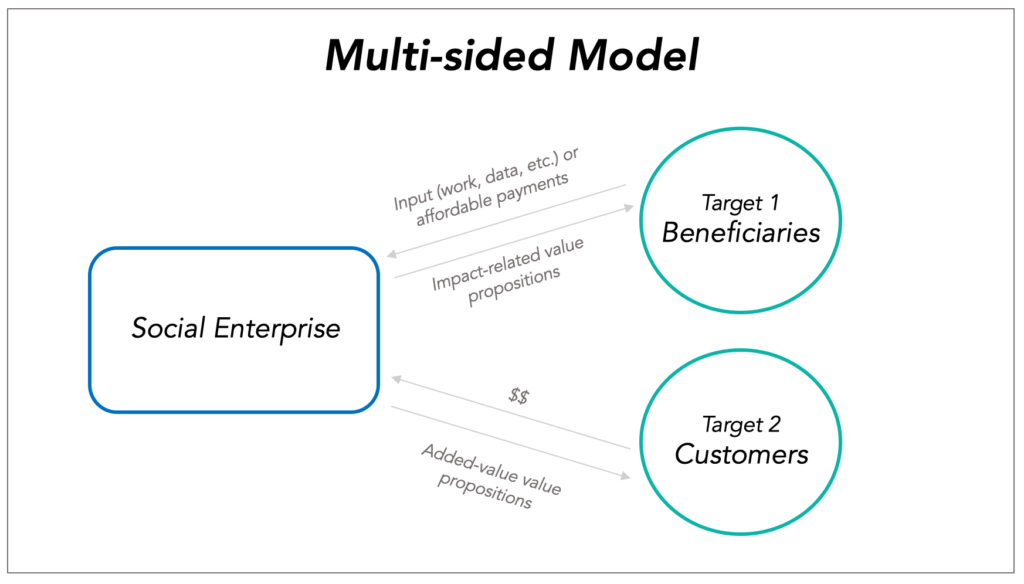
Multisided business model
What it is and how social enterprises can use it
Nowadays, more and more businesses are no longer serving just one type of customers. Actually, many of them simultaneously serve two or more targets. This also happening with several social enterprises, seeking to create value for different beneficiaries and customers at the same time.
In this article, we explore multisided business models and we also provide few real life examples.
Multisided business model: a brief overview
According to Business Model Zoo, a multisided business model involves at least 3 parties (triadic, multi-party arrangement). When it comes to social entrepreneurship, such parties usually are: social enterprise, beneficiaries, customers. Here, what happens is that the firm provides different value propositions to its audiences. As a consequence, products, services, solutions, change from target to target.

Recently, DragonFly Collective conducted an interesting analysis on recurring variants of multisided models. A list of common social enterprises business models following this framework is provided below.
1. Customer segment cross-subsidization model
The firms falling into this category deliver pretty much the exact same product/service to two targets (customers and beneficiaries). The first one pays, the other one then receives it for free or at a discounted rate. “One buy, give one” models such as Aravind Eye Care can be considered part of this cluster.
2. Product line cross-subsidization model
Here, the social firm delivers diverse products/services to at least two targets (customers and beneficiaries). Both value propositions tend to build on the same company’s competences and core resources, yet the offerings delivered are not quite the same. This is the case of BioLite and its cooking stoves, for instance. Just like we have seen with the previous cluster, once again the first segment pays, the other one receives the product/service for free or at a discounted rate.

3. Cross-subsidization with parent company model
In this case, the social enterprise solely acts as a funding mechanism for its parent company. Eventually, the profits generated by the enterprise are later used by the parent organization to serve beneficiaries and fulfill its social impact mission.
4. Donation model
To some extent, this model looks quite similar to the previous cluster. Yet, the social enterprise doesn’t donate its profit to a parent company, but to a totally distinct social organization. This organization then uses the funds received to generate positive social change.
5. Employment model
In this cluster, the firm trains and employs beneficiaries, and later sells products/services to conscious customers (at times, willing to pay premium prices to contribute generating impact). Companies such as SEP Jordan or Specialisterne fulfill their mission following this pattern.

But watch out! (Something to be aware of)
Multisided business models shouldn’t be confused with matchmaking models.
As a matter of fact, matchmaking models can be still considered as multi-sided arrangements. However, since the value provided is transactional, firms adopting such model need to have the two groups (typically demand and supply) simultaneously in order for the model to work. Without one of the two segments, there is no chance for the organization to keep collecting any brokerage fee. Conversely, multisided business models serve two different groups, usually beneficiaries and customers. Such segments don’t represent demand and supply, therefore they don’t really depend on each other, as long as the company has some financial runway.
As a result, multisided models come with several risks as well as lots of opportunities. Failure rates are indeed very high for this type of model, as the firm strongly depends on its customers to subsidize both the social impact mission and the overall business infrastructure. Therefore, customer acquisition, retention and growth are critical for long-term sustainability here. However, if implemented correctly, this business model increase brand reputation and visibility, leading to higher chances of scalability.
Conclusion
Wrapping up, when building up a multisided business model, one of the first key steps for firms is to define their different target groups: beneficiaries and (potential) customers. From there, value creation for each group follows accordingly. Eventually, this kind of model can be sustainable as long as each side of the model is correctly understood, engaged and served.
We hope this article has been useful and gave you a first taste of such framework. If you are interested to learn more, we suggest you to read some of our case studies to see how social enterprises are using multisided business models out there, in the real world!
Did you like this article?
If so, then don’t forget to check out for more at Impact Jungle.